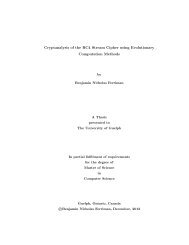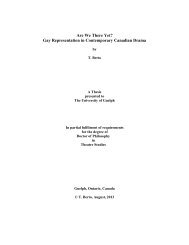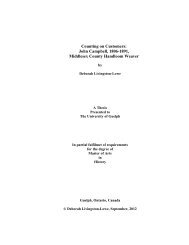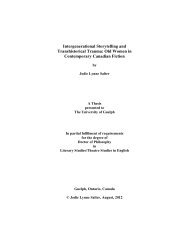THESIS - ROC CH ... - FINAL - resubmission.pdf - University of Guelph
THESIS - ROC CH ... - FINAL - resubmission.pdf - University of Guelph
THESIS - ROC CH ... - FINAL - resubmission.pdf - University of Guelph
You also want an ePaper? Increase the reach of your titles
YUMPU automatically turns print PDFs into web optimized ePapers that Google loves.
6.4.4 FTIR Analysis<br />
FTIR analysis was carried out to elucidate the presence <strong>of</strong> interactions between<br />
cellulose and SPI. Only samples aged at 58% RH were used for comparison. Figure 6.9 shows<br />
the overview <strong>of</strong> the spectra for all specimens including extracted SMF’s and glycerol.<br />
Absorbance<br />
Figure 6.9: FTIR spectra <strong>of</strong> SPI/Cellulose blend films and SPI control along with extracted SMF<br />
specimen.<br />
SMF2.5%<br />
SMF1.0%<br />
SMF0.5%<br />
SMF0.25%<br />
SNF0.25<br />
SPI<br />
glycerol<br />
SMF<br />
3800<br />
3400<br />
3000<br />
2600<br />
Upon initial assessment <strong>of</strong> the overall FTIR spectra, no obvious differences between<br />
cellulose added and SPI control films were exhibited. Since the content <strong>of</strong> cellulose is below<br />
2.5%, clear identification through the spectra was not expected. It can be seen from Figure 6.9<br />
that the identifying peaks near 1600 cm -1 and 1040 cm -1 from SMF’s can easily be<br />
overshadowed by the presence <strong>of</strong> SPI and glycerol. However, evidence <strong>of</strong> cellulose interactions<br />
2200<br />
Wavenumber cm -1<br />
maybe elucidated through further analysis <strong>of</strong> the blend films.<br />
80<br />
1630<br />
1800<br />
1540<br />
1230<br />
1400<br />
1117<br />
1000<br />
1040<br />
600

















